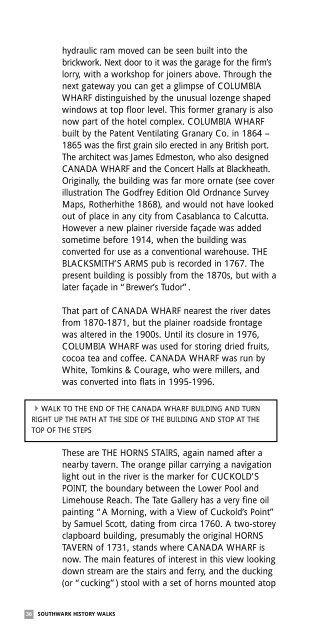Granaries, Shipyards and Wharves - Cycling from Guildford
Granaries, Shipyards and Wharves - Cycling from Guildford
Granaries, Shipyards and Wharves - Cycling from Guildford
Create successful ePaper yourself
Turn your PDF publications into a flip-book with our unique Google optimized e-Paper software.
hydraulic ram moved can be seen built into the<br />
brickwork. Next door to it was the garage for the firm’s<br />
lorry, with a workshop for joiners above. Through the<br />
next gateway you can get a glimpse of COLUMBIA<br />
WHARF distinguished by the unusual lozenge shaped<br />
windows at top floor level. This former granary is also<br />
now part of the hotel complex. COLUMBIA WHARF<br />
built by the Patent Ventilating Granary Co. in 1864 –<br />
1865 was the first grain silo erected in any British port.<br />
The architect was James Edmeston, who also designed<br />
CANADA WHARF <strong>and</strong> the Concert Halls at Blackheath.<br />
Originally, the building was far more ornate (see cover<br />
illustration The Godfrey Edition Old Ordnance Survey<br />
Maps, Rotherhithe 1868), <strong>and</strong> would not have looked<br />
out of place in any city <strong>from</strong> Casablanca to Calcutta.<br />
However a new plainer riverside façade was added<br />
sometime before 1914, when the building was<br />
converted for use as a conventional warehouse. THE<br />
BLACKSMITH’S ARMS pub is recorded in 1767. The<br />
present building is possibly <strong>from</strong> the 1870s, but with a<br />
later façade in “Brewer’s Tudor”.<br />
That part of CANADA WHARF nearest the river dates<br />
<strong>from</strong> 1870-1871, but the plainer roadside frontage<br />
was altered in the 1900s. Until its closure in 1976,<br />
COLUMBIA WHARF was used for storing dried fruits,<br />
cocoa tea <strong>and</strong> coffee. CANADA WHARF was run by<br />
White, Tomkins & Courage, who were millers, <strong>and</strong><br />
was converted into flats in 1995-1996.<br />
�WALK TO THE END OF THE CANADA WHARF BUILDING AND TURN<br />
RIGHT UP THE PATH AT THE SIDE OF THE BUILDING AND STOP AT THE<br />
TOP OF THE STEPS<br />
These are THE HORNS STAIRS, again named after a<br />
nearby tavern. The orange pillar carrying a navigation<br />
light out in the river is the marker for CUCKOLD’S<br />
POINT, the boundary between the Lower Pool <strong>and</strong><br />
Limehouse Reach. The Tate Gallery has a very fine oil<br />
painting “A Morning, with a View of Cuckold’s Point”<br />
by Samuel Scott, dating <strong>from</strong> circa 1760. A two-storey<br />
clapboard building, presumably the original HORNS<br />
TAVERN of 1731, st<strong>and</strong>s where CANADA WHARF is<br />
now. The main features of interest in this view looking<br />
down stream are the stairs <strong>and</strong> ferry, <strong>and</strong> the ducking<br />
(or “cucking”) stool with a set of horns mounted atop<br />
36 SOUTHWARK HISTORY WALKS


